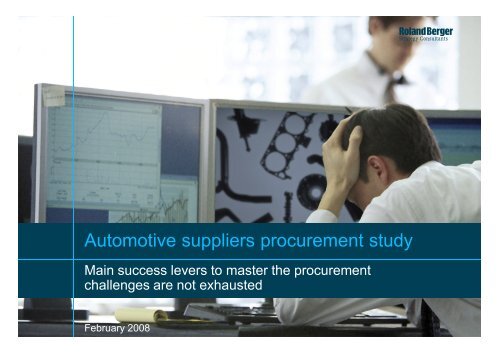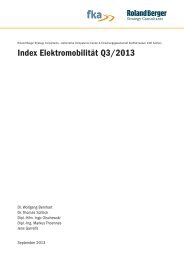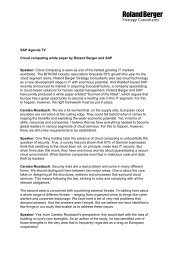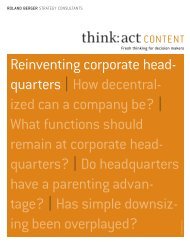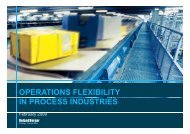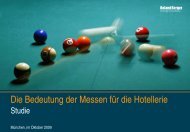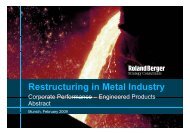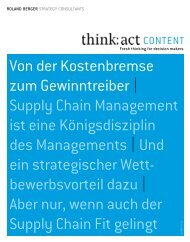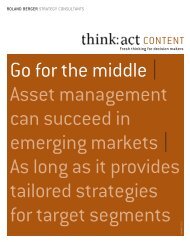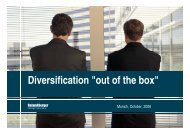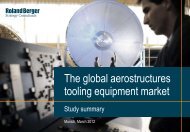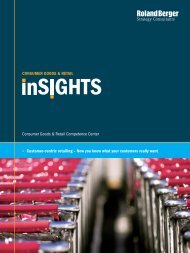Automotive suppliers procurement study - Roland Berger Strategy ...
Automotive suppliers procurement study - Roland Berger Strategy ...
Automotive suppliers procurement study - Roland Berger Strategy ...
- No tags were found...
Create successful ePaper yourself
Turn your PDF publications into a flip-book with our unique Google optimized e-Paper software.
<strong>Automotive</strong> <strong>suppliers</strong> <strong>procurement</strong> <strong>study</strong>Main success levers to master the <strong>procurement</strong>challenges are not exhaustedFebruary 2008STR-90008-481-02-02-E.ppt 1
Management Summary150 international supplier executives of the automotive industry were questioned regardingfuture <strong>procurement</strong> market trends and to the usage of optimization levers within their companies.73% of the <strong>suppliers</strong> assume tougher market conditions for the future, especially by a furtherincrease of raw material prices in combination with constantly high price pressure from the OEMs.All executives suppose that the key levers in the <strong>procurement</strong> environment for additional supplycost savings are not exhausted, eg. joint design-to cost approach with sub <strong>suppliers</strong> before SOPCommon experiences reveal that by the best possible combination of all <strong>procurement</strong> levers costsavings of up to 20-25% are possible. Due to daily internal routines the average realizes 3-4%Additional topics like ‘low cost country sourcing’ or professional ‘negotiation management’ gethigher priority and amend classic purchasing topics like standardization or make-or-buy analysesIn this context the <strong>suppliers</strong> have to redesign the department interplay of project and serialpurchasing in combination with R&D as well as the quality department to reveal the best resultsThe <strong>procurement</strong> departments face the necessity to align their organizational and process requirements– a balancing act of organizational efficiency and realization of cost savingsSTR-90008-481-02-02-E.ppt 2
ContentsPageA. The challenge: Despite continuous efficiency increases the <strong>procurement</strong>of the supplier industry still faces many hurdles 4B. Status quo: The material cost saving potential of the <strong>procurement</strong> is notexhausted – many key levers are not fully implemented 12C. Solution: Need to setup a holistic <strong>procurement</strong> approach designed tomaster the upcoming challenges 21D. <strong>Roland</strong> <strong>Berger</strong> experience – Strong expertise in <strong>procurement</strong> for theautomotive industry drives superior project results 37Authors contacts 44This document was created for the exclusive use of our clients. It is not complete unless supported by the underlying detailed analyses and oral presentation. It must notbe passed on to third parties except with the explicit prior consent of <strong>Roland</strong> <strong>Berger</strong> <strong>Strategy</strong> Consultants.STR-90008-481-02-02-E.ppt 3
A. The challenge: Despite continuous efficiency increases the<strong>procurement</strong> of the supplier industry still faces many hurdlesSTR-90008-481-02-02-E.ppt 4
The pressure on automotive <strong>suppliers</strong> has significantly increasedover the past years – Suppliers are in a "sandwich" positionThe automotive powerplayEND USERSOEMs• Stagnation of demand in triad markets• Increasing price sensitivity and focus on total cost of ownership• Growing awareness for environmental issues• Decreasing brand loyalty• Proliferation of product portfolio• Growing attention to low cost car concepts• Strive for technology innovations in the Powertrain to reduce vehicle emissions• Further reduction of vertical integration, also in product design/engineering• Shift of investment focus to emerging markets (esp. Russia and India)• Attempts to reduce structural overcapacities (e.g. through increasedmanufacturing plant flexibility)SUPPLIERSOngoing intense pressure on marginsRAW MATERIALPROVIDERS• Ongoing raw material price increases• High bargaining power driven by consolidation (e.g. steel & aluminum)Source: <strong>Roland</strong> <strong>Berger</strong>/RothschildSTR-90008-481-02-02-E.ppt 5
Procurement saving targets of <strong>suppliers</strong> are mainly defined by acontinuous demand for decreasing prices of all OEMsOverview on main OEM cost saving programsOEMCost savingprogramTargeted savings[EUR bn]Estimated pricepressure on <strong>suppliers</strong>CORE4.55-6% p.a.EfficiencyoptimizationprogramFor Motion/For Motion Plus6.07.0-4/-6% p.a.-6/-7% p.a.OEMs requireyearly pricereductions of4% to 7% p.a.OLYMPIA2.0-6% p.a.STR-90008-481-02-02-E.ppt 6
The market is widely expected to become even tougher – Furtherincreasing raw material prices are considered as main challenge …Market trends development – Survey resultsIncrease of market trends during next yearsRaw material pricesLow-cost country sourcingCompetitor consolidation73%68%84%Market conditions for<strong>suppliers</strong>Part/product variety68%Harder73%Development cycle timesMultiple sourcing of OEMs42%37%Joint <strong>procurement</strong> platforms21%Same24%"Increase"/"strong increase" in % of all respondentsEasier 3%STR-90008-481-02-02-E.ppt 7
… which might be caused by the price increases of main rawmaterials for the automotive industry during the last yearsRaw material price and US-dollar developmentCrude Oil-Brent Cur. Month FOB [USD/BBL]Aluminium Alloy Cash [USD/MT][USD]10050+61% [USD]+28%3.0002.0001.0000JanDec JanDec0JanDec JanDec2006200720062007Steel, Hot rolled Coil [USD/MT]US-Dollar [USD/EUR]World steel/price index8006004002000Jan2006+57% USD decrease-20%0,50,0Dec JanDecJanDec Jan2007200620071,0DecSTR-90008-481-02-02-E.ppt 8
Purchasing departments are acting in a field of various differentrequirements – Performance pressure further increasesInfluencing factors of current supplier <strong>procurement</strong>INTERNAL FACTORS• Continuous high saving targets per purchaser each year• Capacity reduced in the past for efficiency reasons• More internal interfaces by internationalization• High data availability and transparency demanded• Additional requirements from production and quality dep.• Earlier involvement in R&D projects• …• High price pressure of OEMs• Increasing/fluctuating raw material prices• Currency exchange rates• New competitors from emerging markets• Professionalization of global <strong>procurement</strong>• Shorter innovation cycles lead to decreased supply times• Multiple OEM sourcing strategies• ...EXTERNAL FACTORSPROCUREMENTREQUIREMENTSHighest operationalefficiencyandhighest materialcost savingsSTR-90008-481-02-02-E.ppt 9
Material costs count for more than 50% of all costs in the supplierindustry – Main optimization lever with an 1:1 profit impactCost breakdown example of automotive <strong>suppliers</strong>Average supplier P/L breakdown 2006100% 26%54%REMARKS• Despite continuous price decreasesin all sectors, the relative share ofmaterial cost is risingTotaloutputPersonalcostsMaterialcosts9%5%1% 5%SG&A D&A Interest EBT• In this context, the realization ofpotential cost savings in thepurchase can mainly contributeto an optimum company result• Besides the pure cost reduction ofmaterials, the optimization of theintegrated <strong>procurement</strong> processcan deliver additional reductionsSource: IKB; <strong>Roland</strong> <strong>Berger</strong> researchSTR-90008-481-02-02-E.ppt 10
Key objective of this <strong>study</strong>: Identify main market trends and leversfor automotive <strong>suppliers</strong> to optimize their <strong>procurement</strong> businessSummary of <strong>study</strong> objectives and approachStudy objectives• Provide an overview on the assessment offuture <strong>procurement</strong> market trends in theautomotive supplier industry• Identify main success levers forautomotive <strong>suppliers</strong> to optimizetheir <strong>procurement</strong> business• Understand the different degree of usingoptimizing levers within the companies• Indicate possible solutions and potentialcost savings by project examplesAPPROACH• Procurement survey with a questionnaireat 150 international automotivesupplier executives• Analysis and benchmarking ofoperational <strong>procurement</strong> data• Desk research• Incorporation of <strong>Roland</strong> <strong>Berger</strong>project experienceSTR-90008-481-02-02-E.ppt 11
B. Status quo: The material cost saving potential of the <strong>procurement</strong>is not exhausted – many key levers are not fully implementedSTR-90008-481-02-02-E.ppt 12
High cost reduction potentials of an integrated material groupstrategy and of a design-to-cost approach only insufficiently usedOptimization priorities of <strong>suppliers</strong> reflected to cost saving rangesProcurementmodulesOptimizationprioritySaving rangeof projectsPOSSIBLE OBSTACLESMaterial group strategy69% 5-10%Design-to-cost58%10-12%Organization/processes 1) 28%4-12%Negotiation management53%3-6%Sourcing strategy47%7-12%Supplier management42%2-5%"High"/"very high" in % of all respondents• Internal / external dataavailability and transparency• Incentive systems not in line withoverall targets (eg. discounts)• Long lasting relations betweenpurchaser and sub supplier• Interface responsibilities notclearly defined / measured• Contradictionary targets of R&D,quality and <strong>procurement</strong>• Capacity restrictions caused bydaily routines• Time pressure, especially in theproject phase1) Not included in survey. Derived from project experienceSTR-90008-481-02-02-E.ppt 13
Despite clearly defined material groups in the companies theinternal strategy realization seems to be challengingMaterial group strategy – Survey resultsImplementationREMARKSClear definition/differentiationof material groupsTransparency of market andinternal supply dataRegular performance/realizationof make-or-buy analysesPeriodic performance/realizationof standardization analyses42%32%63%84%IndirectIndirectDirectDirectModule levers Saving impact 1) STR-90008-481-02-02-E.ppt 14• Maximum saving potentialregarding g the addressed volumeis 5-10%• 68% of the <strong>suppliers</strong> considerthe internal degree of animplemented material groupstrategy as high/very high• Additional cost cutting potentialis ‘high/very high’ say 69% of theexecutives• Main obstacles are the timeconsuming data research andthe missing internaltransparencylow to high cost savings"High"/"very high" in % of all respondentsOptimization focus1) Project experience
Only for 26% of the companies the implementation degree of acommon design-to-cost approach with the sub <strong>suppliers</strong> is highDesign-to-cost – Survey resultsModule leversImplementationSaving impact 1)REMARKSStandardization internal/externalproduct benchmarkingCooperation of purchasing andengineering in developmentContinuous complexity andcost driver analysisSub supplier involvement forvalue engineering workshoplow to high cost savings53%42%37%37%IndirectIndirectDirectDirect• Maximum saving potentialregarding the addressed volumeis 10-20%• Just 26% of the <strong>suppliers</strong> considerthe internal degree of animplemented design-to-costapproach as high/very high• Additional cost cutting potentialis high/very high say 58% of theexecutives• Main obstacles are the detailedtechnology know-how and thehigh effort for the involvedparties, eg. <strong>suppliers</strong>, Quality,R&D, Procurement"High"/"very high" in % of all respondentsOptimization focus1) Project experienceSTR-90008-481-02-02-E.ppt 15
Bundling and realization of current payment conditions are veryefficient negotiation levers – Used by just 50% of the <strong>suppliers</strong>Negotiation management – Survey resultsModule levers Implementation Saving impact 1) REMARKSNegotiation planning, preparationand result documentationRealization of current paymentconditionsBundling of project and serialvolumes during awardingUsage of reverse auctions forawarding of new volumes5%53%47%42%IndirectDirectDirectDirect• Maximum saving potentialregarding the addressed volumeis 3-6%• Just 21% of the <strong>suppliers</strong> considerthe internal degree of animplemented negotiationmanagement as high/very high• Additional cost cutting potentialis high/very high say 53% of theexecutives• Main obstacles are establishedcomfort zones, sub supplierrelations, time pressure ormisleading incentive systemslow to high cost savings"High"/"very high" in % of all respondentsOptimization focus1) Project experienceSTR-90008-481-02-02-E.ppt 16
Only the half of all <strong>suppliers</strong> use the cost cutting potential of mainsourcing levers like volume bundling or LCC sourcingSourcing strategy – Survey resultsModule levers Implementation Saving impact 1) REMARKSVolume bundling opportunitiesand usage of reallocationRegular analyses of low-costcountry sourcing opportunitiesOptimum of actual supplierportfolioClear definition of suppliercategories/pyramids58%53%53%47%DirectDirectIndirectIndirect• Maximum savings potentialregarding the addressed volumeis 7-12%• 58% of the <strong>suppliers</strong> considerthe internal degree of an implementedsourcing strategy ashigh/very high• Additional cost cutting potentialis high/very high say 47% of theexecutives• Main obstacles are internationalexperiences, data sources andlong lasting supply relationslow to high cost savings"High"/"very high" in % of all respondentsOptimization focus1) Project experienceSTR-90008-481-02-02-E.ppt 17
Active improvement of quality and logistics performance of sub<strong>suppliers</strong> rarely used – Excellent lever in yearly price negotiationsSupplier management – Survey resultsModule levers Implementation Saving impact 1) REMARKSContinuous supplier qualityassessments in logisticsContinuous supplier quality assessmentsin project/serial phaseOptimum of the actual PPAP/MPA approachRegular performance of supplierimprovement workshopslow to high cost savings32%58%54%68%IndirectIndirectIndirectDirect• Maximum saving potentialregarding the addressed volumeis 2-5%• 53% of the <strong>suppliers</strong> considerthe internal degree of animplemented suppliermanagement as high/very high• Additional cost cutting potentialis high/very high say 42% of theexecutives• Main obstacles are sharedinterface responsibilities withproduction and quality departmentsas well as missingconcepts/processes"High"/"very high" in % of all respondentsOptimization focus1) Project experienceSTR-90008-481-02-02-E.ppt 18
Balancing organizational efficiency and realization of cost savingsis a challenging issue due to company individual requirementsOrganization/processes – Survey resultsCompany ratios on <strong>procurement</strong>Procurementvolume/sales[%][ ]Employees<strong>procurement</strong>/totalemployees p y [%][ ]Procurementvolume/purchaser[EUR[ m] ]92%1.7%18.0REMARKS• Benchmarking of operational figureshas to be reflected to organizationalstructures and purchased materials• Material cost depends mainly on thecompany's degree of value added42%Min.51%ØMax.0.3%Min.0.9%ØMax.4.4Min.8.8ØMax.• Degree of internationalization andorganizational complexity definesthe ratio of necessary purchasers– next to the material groups• Procurement volume per purchaserdepends on the supply materialsand productsSTR-90008-481-02-02-E.ppt 19
Top performers achieve purchasing cost reductions of 5-6 % peryear – Saving potential especially before SOP is much higherPotential cost savings and dimensionsAnnual material cost reduction[% of total material cost]Levers to reduce purchasing cost[total <strong>procurement</strong> cost reduction potential in %] 1)5-6%High10-20%Design-to-costSourcingstrategy7-12%3-4%PotentialcostsavingsOrganization/processes4-12%5-10%Material groupstrategy1-2%3-6%WeakAverageBenchmarkLowProjectSuppliermanagement2-5%ProductphaseNegotiationmanagementSeries1) In relation to purchasing volume addressedSTR-90008-481-02-02-E.ppt 20
C. Solution: Need to setup a holistic <strong>procurement</strong> approach designedto master the upcoming challengesSTR-90008-481-02-02-E.ppt 21
Procurement in the supplier industry – Optimization and costreduction programs should consist of the six correlated modulesOverview pyramidal module system and objectives3Design-tocost1Material groupstrategy2Sourcingstrategy4Suppliermgmt.6Organization/processes5Negotiationmgmt.1 Optimization of material demandstructures2 Optimization of the supplier portfolio3 Cost reduction of products duringproject/development phase4 Improvement of supplier managementprocesses5 Advanced negotiation managementfor cost reduction6 Streamlined organization/processesaccording to defined strategiesSTR-90008-481-02-02-E.ppt 22
Team <strong>Roland</strong> <strong>Berger</strong>HenkelSchmittHagenmeyerHollmannKaiser FlorianKohrRenzowSchnieperTrenkwalderJanuary1 2 3 4 5 6 7 8M T W T F S S M T1 MATERIAL GROUP STRATEGYIn our projects an explicit defined material group strategy is thebasis for the derivation of optimization levers in all other modulesMaterial group strategy – Project fact sheetOBJECTIVEOptimization of complete material demand structure:• Determination of Make-or-buy for selected parts,components• Realization of potential cost savings, e.g. carry over partsPROJECT KEY RESULTS• Transparency on actual material demand• Concept Make-or-buy/standardization• Evaluated catalog of improvement leversMethodical approach/toolsSupply data/market analysisSupplier and part catalogsRisk assessmentMake-or-buy analysisStandardization analysisEffort to use toollowhighMain sub results1.1 Transparency on actual demands1.2 Concept of commodity structure1.3 Concept/measures Make-or-buy1.4 Risk analysis in commodity groupsDocumentsModularization evaluation1.5Measure catalog standardizationMorphological raster1.6Revised implementation planSTR-90008-481-02-02-E.ppt 23
2 SOURCING STRATEGYA clear sourcing strategy should be developed by a proved approach– Comprehensive perspective essential for the implementationSourcing strategy – Project fact sheetOBJECTIVEOptimization of supplier portfolio for each material group:• Identification of possible cost advantages in low costcountries• Bundling of volumes at strategic <strong>suppliers</strong>PROJECT KEY RESULTS• Classified/revised supplier portfolios• Potential saving targets (e.g. volumebundling/LCC souring)Methodical approach/toolsSupplier pyramids/categoriesSupplier portfolio optimizationVolume bundling/reallocationLow cost country sourcingScoring models for relocationsEffort to use toollowhighMain sub results2.1 Concept target supplier portfolio2.2 Concept supplier requirements2.3 Demand/target volume bundling2.4 Catalogue of LCC sourcing optionsDocuments+ =Internal Sourcing Committee2.5Brief supply market assessmentMarket analysis/supplier visits etc.2.6Revised implementation planSTR-90008-481-02-02-E.ppt 24
3 DESIGN-TO-COSTHow we try to maximize cost reductions during the developmentphase – Involvement of sub <strong>suppliers</strong> for design-to-cost activitiesDesign-to-cost – Project fact sheetOBJECTIVECost optimization of projects/products duringdevelopment phase:• Identification of design and specification simplifications• Reduction of material and process effortPROJECT KEY RESULTS• Realizable optimization measures pro part• Significant product simplifications• Quantified cost reduction potentialsMethodical approach/toolsLife cycle assessmentProduct benchmarkingProduct disassemblingDFMA analysisCost driver analysisEffort to use toollowhighMain sub results3.1 Documented approach/process3.2 Benchmarking results pro product3.3 Cost driver/complexity catalogue3.4 Evaluated re-design leversABCABCABCComplexity analysis3.5Project/product priority catalogueDocumentsWorkshops with <strong>suppliers</strong>3.6Revised implementation planSTR-90008-481-02-02-E.ppt 25
Team <strong>Roland</strong> <strong>Berger</strong>HenkelSchmittHagenmeyerHollmannKaiser FlorianKohrRenzowSchnieperTrenkwalderJanuary1 2 3 4 5 6 7 8M T W T F S S M T4 SUPPLIER MANAGEMENTWe establish quality & logistics management with <strong>suppliers</strong> inadvance to the serial production to minimize risks and costsSupplier management – Project fact sheetOBJECTIVEOptimization of supplier management processes:• Early identification of potential levers with <strong>suppliers</strong>• Installation of an integrated supplier management systemPROJECT KEY RESULTS• Optimized cost structure at current <strong>suppliers</strong>• Reduced project risks before SoP• Reduced project and ramp-up costsMethodical approach/toolsTotal cost evaluationQuality assessmentLogistic assessmentAwarding risk assessmentPPAP/MPA analysisEffort to use toollowhighMain sub results4.1 Criteria for supplier assessments4.2 Processes for supplier development4.3 Risk assessment awardings4.4 Optimized supplier portfolioCriteriaRedSupplier workshops4.5KPI catalogue supplier performanceKPI definition/monitoring4.6Revised implementation planSTR-90008-481-02-02-E.ppt 26
Team <strong>Roland</strong> <strong>Berger</strong>HenkelSchmittHagenmeyerHollmannKaiser FlorianKohrRenzowSchnieperTrenkwalderJanuary1 2 3 4 5 6 7 8M T W T F S S M T5 NEGOTIATION MANAGEMENTOverall planning and preparation of yearly price negotiations aswell as monitoring the sustainability of results is essentialNegotiation management – Project fact sheetOBJECTIVEMaterial cost reduction by optimal preparednegotiations:• Planning of negotiation schedule and detailed preparation• Development of stringent storyline and argumentsPROJECT KEY RESULTS• Material price reductions (project/series)• Optimized bonus/one time payments• Improved payment conditions (e.g. discount)Methodical approach/toolsA/B/C supplier initiative analysisNegotiation preparation/planningCost structure (BoM) 1) analysisNegotiation performanceNew payment conditionsEffort to use toollowhighMain sub results5.1 Supplier list incl. targets, volumes5.2 Material price calculation models5.3 Finance model payment conditions5.4 Checklist negotiation preparation231.423 231.423231.423231.423056.156 056.156056.156056.156812.685812.685812.685 812.685231.423231.423231.423 231.423Checklist______________Comprehensive result tracking5.5Master negotiation presentationWorkshops/trainings with buyers5.6Controlling/monitoring toolABCABCABC1) BoM = Bill of MaterialSTR-90008-481-02-02-E.ppt 27
Team <strong>Roland</strong> <strong>Berger</strong>HenkelSchmittHagenmeyerHollmannKaiser FlorianKohrRenzowSchnieperTrenkwalderJanuary1 2 3 4 5 6 7 8M T W T F S S M T6 ORGANIZATION & PROCESSESThe purchasing organization has to be enabled to realize thedefined strategies and to continuously improve the performanceOrganization/processes – Project fact sheetOBJECTIVEOptimized purchasing structures as basis to realize thestrategy:• Adjusted organization/processes• Improvement of interface functions (e.g. engineering)PROJECT KEY RESULTS• <strong>Strategy</strong> related purchasing organization• Improved processes/interface functions• Trained employeesMethodical approach/toolsTop-down benchmarkingProcess gap analysisBest practice organizationScoring model interface assessmentBasic manpower evaluationEffort to use toollowhighMain sub results6.1 Assessed gap analysis6.2 Concept target organization6.3 Concept target processes6.4 Evaluated interface scoringEmployee skills analysis6.5Training concept buyers__________________Buyer workshops/trainings6.6Revised implementation plan1) BoM = Bill of MaterialSTR-90008-481-02-02-E.ppt 28
Example for an integrated optimization program in parallel to daily<strong>procurement</strong> routines – High return on implementationIntegrated project exampleProject descriptionPROJECT MODULESOPTIMIZATION LEVERSPROJECT SCOPE• Development of anintegrated suppliermanagement program• Increasing <strong>procurement</strong>efficiency• Development of valueengineering with sub<strong>suppliers</strong>CLIENT• Tier 1 supplier of interiorcomponents• Revenues of EUR 2 bn,thereof EUR 650 mwithin the project scopeDURATION• Launch period (3 weeks)• Detailing/implementation(9 months)Portfolio management/sourcing strategySupplier management/developmentValue engineering/design-to-costQuick wins123PORTFOLIO MANAGEMENT• Definition of bundling strategies• Reorganization of the supplier portfolioSOURCING STRATEGY• Optimization of sourcing strategies• Adaptation of sourcing instrumentsSUPPLIER MANAGEMENT• Development of an sub supplierassessment and improvement system• Optimization of management until andafter SOP4 DESIGN-TO-COST• Integration of supplier innovations• Development of joint value engineering5 QUICK-WINS• Material group related optimization• Optimization of supplier contracting• Improvement of discount conditions• Optimizedprocessesand instruments• Additionalsavingpotential ofEUR 75 m(in 3 years)STR-90008-481-02-02-E.ppt 29
D. <strong>Roland</strong> <strong>Berger</strong> experience – Strong expertise in <strong>procurement</strong>for the automotive industry drives superior project resultsSTR-90008-481-02-02-E.ppt 30
Within our competence center we advice the leading internationalcompanies of the automotive industryOverview selected international clientsOEMs SUPPLIERS SERVICE PROVIDERSSTR-90008-481-02-02-E.ppt 31
Our global team successfully realized <strong>procurement</strong> projects for theglobal TOP automotive playersOverview – Extract of automotive <strong>procurement</strong> projects<strong>Roland</strong> <strong>Berger</strong> <strong>Automotive</strong> TeamUSAUSA4 Partners20 ConsultantsWESTERNEUROPE8 Partners50 ConsultantsSOUTH AMERICA1 Partner5 ConsultantsRUSSIA1 Partner10 ConsultantsEASTERNEUROPE2 Partners15 ConsultantsJAPAN4 Partners20 ConsultantsCHINA2 Partners20 ConsultantsPROJECT EXAMPLES• Product cost reduction program for aTop 5 automotive supplier• Chinese sourcing strategy andimplementation for a Tier 1• Make-or-buy strategy and LCCsourcing evaluation for a Tier 1/2• Global purchasing strategy for anGerman OEM• Integrated supplier managementsystem at a Tier 1• Cost reduction program for general/investment goods at a Tier 2• Developing a purchasing KPI-systemat a Tier 2STR-90008-481-02-02-E.ppt 32
With recent automotive studies we inject highly valuable knowhowfrom day one in each client projectOverview on recent automotive studies (selection)REGIONS TECHNOLOGIES MARKET STRUCTUREChina <strong>study</strong>(2006)Powertrain<strong>study</strong> (2007)Low cost car<strong>study</strong> (2007)• Assessment of automotivetechnologies/ capability• Opportunities for sourcing fromChinaRussia <strong>study</strong>(2005/2006)• Development of the Russianautomotive market• Implications for OEMs and<strong>suppliers</strong>• Developments in Powertraintechnologies• Strategies how to meet the newemission regulationsElectronics<strong>study</strong>(2006/2007)• Key trends/ challenges inautomotive E/E• Implications for OEMs and<strong>suppliers</strong>• Trends in low cost car (LCC)segment and implications• Implications for R&D of Lowcost cars<strong>Automotive</strong>supplier <strong>study</strong>(2007/2008)• Supplier benchmarking• Identification of Top/lowperformers• Success factors for <strong>suppliers</strong>STR-90008-481-02-02-E.ppt 33
Authors of the automotive <strong>suppliers</strong> <strong>procurement</strong> <strong>study</strong>Marcus BerretPartnerLeader of the globalautomotive supplier team> 12 years of internationalconsulting experience+49 89 9230-8737marcus_berret@de.rolandberger.comDr. Marcus HoffmannSenior Project ManagerLeader of the automotive<strong>procurement</strong> team6 years of internationalconsulting experience+49 89 9230-8060marcus_hoffmann@de.rolandberger.comSTR-90008-481-02-02-E.ppt 34


